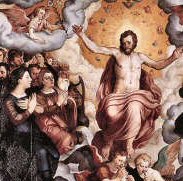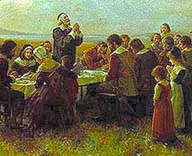This Month, November 2021 we Celebrate the Holy Saints and Holy Souls. Along with many Canonized Saints. Many Saints have had encounters with God's Holy Angels. In this Blog we try to share our and the Saints encounters with the Holy Angels.
I have found the most interesting Website that I am sharing with you now about this Month's Saints Feast Days... Check out the blue link below
"Highlights of the Month"
 "During November, as in all of Ordinary Time (Time After Pentecost), the Liturgy signifies and expresses the regenerated life from the coming of the Holy Spirit, which is to be spent on the model of Christ's Life and under the direction of His Spirit. As we come to the end of the Church year we are asked to consider the end times, our own as well as the world's. The culmination of the liturgical year is the Solemnity of Our Lord Jesus Christ, King of the Universe. "This feast asserts the supreme authority of Christ over human beings and their institutions.... Beyond it we see Advent dawning with its perspective of the Lord's coming in glory."— The Liturgy and Time, A.G. Mortimort"
"During November, as in all of Ordinary Time (Time After Pentecost), the Liturgy signifies and expresses the regenerated life from the coming of the Holy Spirit, which is to be spent on the model of Christ's Life and under the direction of His Spirit. As we come to the end of the Church year we are asked to consider the end times, our own as well as the world's. The culmination of the liturgical year is the Solemnity of Our Lord Jesus Christ, King of the Universe. "This feast asserts the supreme authority of Christ over human beings and their institutions.... Beyond it we see Advent dawning with its perspective of the Lord's coming in glory."— The Liturgy and Time, A.G. Mortimort"
"This month the main feasts are the Solemnity of All Saints (November 1), The Commemoration of All the Faithful Departed (All Souls) (November 2), St. Martin de Porres (November 3), St. Charles Borromeo, (November 4), Feast of the Dedication of the Lateran Basilica in Rome (November 9), St. Leo the Great (November 10), St. Martin of Tours, (November 11), St. Josaphat (November 12), St. Frances Xavier Cabrini (November 13), St. Albert the Great (November 15), Sts. Margaret of Scotland and Gertrude (November 16), St. Elizabeth of Hungary (November 17), the The Solemnity of Our Lord Jesus Christ, King of the Universe (November 21), St. Cecilia (November 22), Sts. Clement I and St. Columban (November 23), St. Andrew Dung-Lac and Companions (November 24), St. Catherine of Alexandria (November 25),and St. Andrew (November 30)."
"The feast of the Presentation of Mary (November 21), is superseded by the Sunday Liturgy."
"Thanksgiving"
 "The national holiday (USA) of Thanksgiving also falls on the last Thursday of November. There is a special liturgy which may be used on this day."
"The national holiday (USA) of Thanksgiving also falls on the last Thursday of November. There is a special liturgy which may be used on this day."
The tradition of eating goose as part of the Martin's Day celebration was kept in Holland even after the Reformation. It was there that the Pilgrims who sailed to the New World in 1620 became familiar with this ancient harvest festival. When, after one year in America, they decided to celebrate a three days' thanksgiving in the autumn of 1621, they went in search of geese for their feast. We know that they also had deer (a present from the Indians), lobsters, oysters, and fish. But Edward Winslow, in his account of the feast, only mentions that "Governor Bradford sent four men on fowling that so we might after a more special manner rejoice together, after we had gathered the fruit of our labours." They actually did find some wild geese, and a number of wild turkeys and ducks as well.
The Pilgrim Fathers, therefore, in serving wild turkeys with the geese, inaugurated one of the most cherished American traditions: the turkey dinner on Thanksgiving Day. They also drank, according to the ancient European tradition, the first wine of their wild-grape harvest. Pumpkin pie and cranberries were not part of the first Thanksgiving dinner in America, but were introduced many years afterward.
The second Thanksgiving Day in the New World was held by the Pilgrims two years later, on July 30, 1623. It was formally proclaimed by the governor as a day of prayer to thank God for their deliverance from drought and starvation, and for the safe arrival from Holland of the ship Anne.
In 1665 Connecticut proclaimed a solemn day of thanksgiving to be kept annually on the last Wednesday in October. Other New England colonies held occasional and local Thanksgivings at various times. In 1789 the federal Congress authorized and requested President George Washington to proclaim a day of thanksgiving for the whole nation. Washington did this in a message setting aside November 26, 1789 as National Thanksgiving Day.
After 1789 the celebration reverted to local and regional observance for almost a hundred years. There grew, however, a strong desire among the majority of the people for a national Thanksgiving Day that would unite all Americans in a festival of gratitude and public acknowledgment for all the blessings God had conferred upon the nation. It was not until October 3, 1863, that this was accomplished, when President Abraham Lincoln issued, in the midst of the Civil War, a Thanksgiving Proclamation. In it the last Thursday of November was set apart for that purpose and made a national holiday."
"Since then, every president has followed Lincoln's example, and annually proclaims as a "Day of Thanksgiving" the fourth Thursday in November. Only President Franklin D. Roosevelt changed the date, in 1939, from the fourth to the third Thursday of November (to extend the time of Christmas sales). This caused so much consternation and protest that in 1941 the traditional date was restored."
"Excerpted from the Handbook of Christian Feasts and Customs, Francis X. Weiser"
Footnote: Site Reference from Catholic Culture


No comments:
Post a Comment